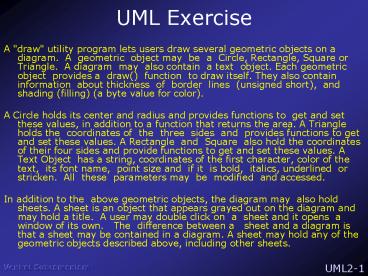UML Exercise - PowerPoint PPT Presentation
Title:
UML Exercise
Description:
A 'draw' utility program lets users draw several geometric objects on a diagram. ... Consider an example of a Car with an Engine. UML2-3. Venkat Subramaniam ... – PowerPoint PPT presentation
Number of Views:24
Avg rating:3.0/5.0
Title: UML Exercise
1
UML Exercise
- A "draw" utility program lets users draw several
geometric objects on a diagram. A geometric
object may be a Circle, Rectangle, Square or
Triangle. A diagram may also contain a text
object. Each geometric object provides a draw()
function to draw itself. They also contain
information about thickness of border lines
(unsigned short), and shading (filling) (a byte
value for color). - A Circle holds its center and radius and provides
functions to get and set these values, in
addition to a function that returns the area. A
Triangle holds the coordinates of the three
sides and provides functions to get and set
these values. A Rectangle and Square also hold
the coordinates of their four sides and provide
functions to get and set these values. A Text
Object has a string, coordinates of the first
character, color of the text, its font name,
point size and if it is bold, italics,
underlined or stricken. All these parameters
may be modified and accessed. - In addition to the above geometric objects, the
diagram may also hold sheets. A sheet is an
object that appears grayed out on the diagram and
may hold a title. A user may double click on a
sheet and it opens a window of its own. The
difference between a sheet and a diagram is
that a sheet may be contained in a diagram. A
sheet may hold any of the geometric objects
described above, including other sheets.
2
Object Copying
- Lets first look at some thing simple and
fundamental - How do we copy an object
- Consider an example of a Car with an Engine
3
Venkats past recommendation
- Before reading Blochs Effective Java!
- Writing a Copy Constructor is a bad idea
- Why?
- Leads to extensibility issues
4
Blochs Recommendation
- Cloning comes with its own problems
- No constructor called when object cloned
- If a class has final fields, these cant be given
a value within close method! - Blochs recommendation
- "... you are probably better off providing some
alternative means of object copying or simply not
providing the capability." He goes on to say "A
fine approach to object copying is to provide a
copy constructor." - I agree with the part simply not providing the
capability - But providing a copy constructor has problems
mentioned earlier? - Whats the solution?
Further Reading 1
5
A combined approach
Further Reading 2
- Implement the clone method
- but not the way it is generally done in Java
- Write a protected copy constructor
- From the clone method, invoke the protected copy
constructor
6
References
- 1. Effective Java, Joshua Bloch
- 2. Why copying an object is a terrible thing to
do? (downloadable from - http//www.AgileDeveloper.com/download.aspx)































